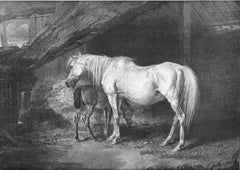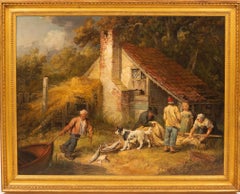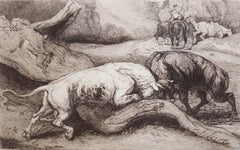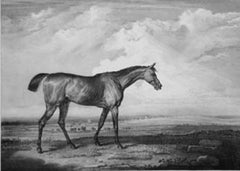James Ward Art
James Ward was influenced by many people, but his career is conventionally divided into two periods: until 1803, his single greatest influence was his brother in law George Morland; from that time, it was Rubens. From 1810 or so, Ward started to paint horses within landscapes; slightly later, he turned to very large-scale landscapes, of which Gordale Scar (Tate, London), completed in 1814 or 1815 and depicting Gordale Scar (Yorkshire) as an example of the sublime, is considered his masterpiece and a masterpiece of English Romantic painting. He was one of the outstanding artists of the day, his singular style and great skill set him above most of his contemporaries, markedly influencing the growth of British art. Regarded as one of the great animal painters of his time, Ward produced history paintings, portraits, landscapes and genre. He started as an engraver, trained by William, who later engraved much of his work. The partnership of William and James Ward produced the best that English art had to offer, their great technical skill and artistry having led to images that reflect the grace and charm of the era. He was admitted for membership into the Royal Academy in 1811. One of Ward's best-known paintings, The deer stealer was commissioned in 1823 for the sum of 500 guineas by Ward's patron Theophilus Levett. When the work was finished, Levett pronounced himself delighted with the results and consequently raised the remuneration to 600 guineas. Subsequently Ward was said to have been offered 1,000 guineas for the painting by 'a nobleman,' which he declined. The painting now hangs at Tate in London.
19th Century Romantic James Ward Art
Lithograph
1830s Romantic James Ward Art
Paper, Watercolor
19th Century Old Masters James Ward Art
Oil
1850s Victorian James Ward Art
Intaglio, Laid Paper, Etching
19th Century Romantic James Ward Art
Lithograph
1820s Romantic James Ward Art
Lithograph
Mid-18th Century James Ward Art
Laid Paper
2010s Realist James Ward Art
Digital Pigment, Permanent Marker, Laid Paper
17th Century Old Masters James Ward Art
Oil, Canvas
1870s Romantic James Ward Art
Lithograph
17th Century Old Masters James Ward Art
Oil, Wood Panel
1750s Old Masters James Ward Art
Oil
Early 19th Century Romantic James Ward Art
Watercolor, Laid Paper
1910s Naturalistic James Ward Art
India Ink, Paper, Watercolor
Gustav MelcherGustav Melcher ( German, 1898 -?) Boats off Venice Italy Ink Water Color c. 1918, 1918
1860s Romantic James Ward Art
Carbon Pencil, Gouache
19th Century Victorian James Ward Art
Aquatint
1910s Victorian James Ward Art
Paper
Late 20th Century Romantic James Ward Art
Watercolor, Paper
Early 19th Century James Ward Art
Watercolor
19th Century Victorian James Ward Art
Oil
19th Century Victorian James Ward Art
Oil
Early 19th Century Realist James Ward Art
Paper, Crayon, Pencil







